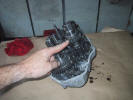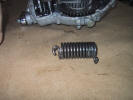
This is the back half of the gear box standing on
end. I am pointing to the main shaft, the aft end of which has the
flexible coupling (yoke) the the rubber driveshaft doughnut slip
onto. Just below my finger is the forward #304 bearing. There is one
more on the output end of the shaft. These bearings hold the
components of the main shaft in place. |

This is 4th gear... |

...this is the 3rd/4th gear shift sleeve, just ahead
and underneath, you can see the first of two main shaft sleeves
which are splined to the main shaft and do not free spin, but turn
with the main shaft. |

Here is the 3rd gear... |

...followed by the 2nd gear. |

This is the 1st/2nd gear shift sleeve. Just above is
the second splined main shaft sleeve which is coupled via splines to
the main shaft. The 1st/2nd shift sleeve is toothed and is what the
reverse idle gear meshes with when reverse is selected with the
neutral/reverse shift lever. |

This is 1st gear. All of the gears are free spinning
on the main shaft. Along the inner diameter face of each gear are
teeth which mesh with the respective shift sleeves via a fork. The
shift sleeves engage both the selected gear and the fixed main shaft
sleeves to lock them together on the main shaft. |

Here you can see one arm of the 1st/2nd shift fork in
the groove of the 1st/2nd shift sleeve. |

This is the fork for 3rd/4th gear. |

The large metal plate is the shift quadrant, I am
pointing to the 1st/2nd shift fork pin, above is the pin for the
3rd/4th gear fork. The fork pins ride through the guide slots as the
foot shift lever is pressed, moving the forks to force the shift
sleeves onto the selected gear or to a neutral position on the main
shaft sleeve. |

This is the forks shaft. The shaft slides through a
bushing in each fork... |

...here you can see the 3rd/4th shift fork better. |

This is the idle bracket assembly shaft... |

...and this is the idle bracket assembly. Just to the
right of my finger you can see 3 teeth of the idle gear. The idle gear
transfers power from the main shaft to the reverse gear via the
toothed 1st/2nd shift sleeve. |

Here is the 12 mm retaining bolt and lock washer for
the idle bracket assembly. |

Here is the clutch shaft. The splines are what stick
out from the front case (case not shown) and engage the clutch plates and
disks in the flywheel. |

This is the 4th gear of the clutch shaft. It is the
only gear which can be removed from the shaft. 4th gear is keyed to
the clutch shaft and held in place by the #205 bearing on the front
of the clutch shaft. Just ahead of the bearing is the clutch shaft
sleeve and underneath that is a washer called the clutch release
slider ring. |

Here is the 3rd gear of the clutch shaft... |

...followed by the 2nd and 1st gear. Just below my
finger the #12204 bearing is just visible. When the clutch shaft is
removed, the outer race for this bearing will remain in the rear
gear box housing. You will need an inside type puller to remove the
outer race from the housing. |

This is the kick start shaft... |

...and kick starter return spring. To remove the
gears from the kick starter shaft, the retaining pin for the spring
must be driven out.
|

Kick starter return spring easily slides of the
shaft. |

Here is the reverse shift fork sitting in the reverse
gear shift sleeve... |

...which is part of the reverse gear. |

This is the kick start gear. |

This bolt is the return spring stop for the foot
shift mechanism. You can see the spring just to the right of my
middle finger. |

This is the internal part foot shift mechanism. I am
pointing to the ratchet crank which engages the...
|

...ratchet wheel, which turns the...
|

...shift quadrant shaft (hard to see, but in-line
with my finger) that moves the shift quadrant and forks.
|

This is the right hand cover which is a cap over the
other end of the shift quadrant shaft. This cover needs to be
removed when performing the gearshift adjustment procedure. A 10mm
wrench is used on this end of the shaft to "feel" when adjusting the
up and down shift set screws on the back of the gear box, left side
(not pictured here).
|

Here is the reverse/neutral shift lever shaft. The
shaft goes through the reverse shift quadrant plate and terminates
against the idle bracket assembly shaft. |

Here the gear box is shown with the shift quadrant in
the neutral position. |

A front view of the gear box in neutral. On the right
side you can see the ratchet pawl is below the 3 notches in the
ratchet wheel. The notches from bottom to top are 2nd, 3rd and 4th
gear. |

The engine/clutch turns the clutch shaft CW as seen
form the front. When using the forward gears... |

...this turns the output end of the main shaft CW as
seen from the rear.
|

In the front half of the case on the right side is
the shift quadrant latch assembly. This spring loaded lever rides
the notches in the face of the shift quadrant to hold the quadrant
in the selected gear position. The older 650cc gear boxes used a
spring loaded ball bearing in place of the latch assembly. |

To shift from neutral to 1st gear, push down once on
the foot shift ratchet crank, then turn the clutch shaft CW
while pressing down slightly on the shift quadrant. The 1st/2nd
shift sleeve will slide aft off the main shaft sleeve and engage 1st
gear. I am pointing to the notch in the shift quadrant for 1st gear.
The latch lever in the previous picture would roll into this detent
if the two case halves where together. |

It is a little difficult to see in this picture, but
the 1st/2nd toothed shift sleeve has moved back flush with the 1st
gear at the back of the case. The back half of the shift sleeve is
engaging the small teeth around the I.D. of the 1st gear while the
front half of the shift sleeve is engaging the main shaft sleeve
which is splined to the main shaft. Now 1st gear is locked to the
main shaft while the rest of the gears spin free. |

To shift into second, depress the foot shift ratchet
crank slightly, slowly turn the clutch shaft CW and press down
slightly on the shift quadrant. I am pointing to the 2nd gear detent
in the shift quadrant.
|

With my hand out of the way it looks like this. |

The 1st/2nd shift sleeve has now moved up to engage
the I.D. teeth on the back of the 2nd gear along with the main shaft
sleeve underneath.
Note the ratchet crank has engaged the 2nd gear
notch in the ratchet wheel on the right side of the picture.
|

Closer view of ratchet mechanism in 2nd gear notch.
Entering 3rd gear is the same drill; press down on
the ratchet crank to disengage the ratchet wheel, turn the clutch
shaft CW and press down slightly on the shift quadrant until the
3rd/4th shift sleeve engages 3rd gear. |

Detent for 3rd gear... |

Clear view of shift quadrant in 3rd. |

The 1st/2nd shift sleeve (under middle finger) is now
riding on the main shaft sleeve while 1st and 2nd gear are free
spinning.
The 3rd/4th shift sleeve (index finger) has
dropped back engaging 3rd gear and the first main shaft sleeve which
is just visible ahead of the shift sleeve. |

The ratchet crank is now in the detent for 3rd gear.
To shift into 4th, repeat the above steps again. |

Pointing to detent in shift quadrant for 4th. |

Side view of shift quadrant in 4th. |

Ratchet crank in 4th gear position.
|

3rd/4th shift sleeve has moved forward to engage 4th
gear.
Return to neutral by depressing the ratchet crank
to disengage the ratchet wheel, turn the clutch shaft CW while
lifting up on the shift quadrant until you return back to 1st gear.
Then use the reverse/neutral lever to put the gear box into neutral |

To get into reverse, rotate the clutch shaft CW while
pressing lightly aft on the reverse/neutral lever (from the neutral
position). |

As you move the reverse lever aft, the reverse shift
quadrant moves up which blocks the forward gears shift quadrant and
allows... |

...the reverse fork to push the reverse gear aft.
There are fingers on the back of the reverse gear that must fall
into holes on the kick starter gear... |

...like so. The grinding you hear and feel when
engaging reverse are these pins falling into place. |

The reverse gear now meshes with the idle assembly
gear which meshes to the toothed 1st/2nd shift sleeve on the main
shaft.
Recall that in "Neutral" the shift sleeves (with
forks) are riding on the main shaft sleeves which are splined to the
main shaft. All the other forward gears are not locked to the main
shaft and are free spinning in neutral. |

Here is a better view of the reverse gear meshed to
the idle which is meshed to the 1st/2nd toothed shift sleeve on the
main gear.
Now as the clutch shaft is turned CW the idle gear
turns the... |

...1st/2nd shift sleeve (index finger) and main shaft
(middle finger)... |

...CCW so the drive shaft moves the motorcycle in
reverse.
Quite a simple and ingenious system. |

Side view of the shift and reverse shift quadrants
while in reverse. |

Note how the reverse shift quadrant (index finger)
when engaged; blocks the shift forks so the gear box can not be
engaged in forward gears at the same time. |

Moving the reverse lever forward drops the reverse
quadrant back to the stop pin... |

...which pushes the reverse fork forward disengaging
the pins from the kick start gear and returning the gear box to a
neutral condition. |

This is the contact for the neutral... |

...switch on the front half of the case. |

Gear box back in neutral. |